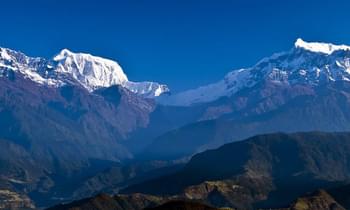If you are interested in participating in this very accessible trek of 130km at about 3000m altitude, then you should take 8-12 weeks to prepare yourself for a mountain trek. Since you would be trekking for a good 9 to 14 days at Mount Everest, it is a good idea to start practising by going on walks and even hikes for a stretch of 5 hours.
The focus here shouldn’t be on the distance covered; instead, it should be the duration, take minimal breaks and start by hiking/walking for 3 - 4 times a week. If you do not have hilly terrain to climb onto, practice on gym equipment for a few hours and a minimum of 5 times a week.
Now, you may be regular with workouts and are quite fit, however, you may still need to do some additional prepping for a mountain trek. The amount of work you would have to put in depends on your current physical condition.
If you are someone who workouts/trains 3 - 4 times a week doing cardio and weights, you will require less time and preparation. If you are someone who isn’t quite regular with exercising, you may want to give yourself a minimum of 12-15 weeks to train for a hike like the EBC.
Moreover, include breathing exercises and meditation as part of your preparations, and you must also get your health examined by a doctor before starting any rigorous training.
Moreover, enough practice and preparation will make the entire trek much more enjoyable. There are 2 options to train yourself for the EBC trek:
1. Practice Hikes:
A practice hike is the closest you can get to the actual hiking experience and is the best way to prepare for Everest base camp. Start by following:
- Hike or go on long walks
- Start by 1 to 2 hours and gradually build it up to 5 to 6 hours with minimal rest intervals
- Initially go twice a week and increase the number of days from there
- Choose a hilly, uneven gravely terrain for these hikes, if possible
- Start without any additional weight, then start wearing your daypack and over time, slowly increase the weight of its contents till it gets to 25lbs
2. Gym Workout:
Working out in your gym you wouldn’t be able to replicate the natural activity however, it would help you improve your overall fitness, which in turn will be beneficial during the EBC hike.
- Spend at least 45 minutes on the treadmill on hill setting (for a walk or a slow jog)
- Practice by climbing staircases or spend 10 minutes on the stair-stepping machine, either of these should be done at a speed of 30-45 steps per minute. You can gradually increase the time limit
- Run on a slope or slow slow walk with no incline for 10 minutes to improve your breathing. Again increase the intensity with time
- Repeat these exercises 2-3 times by performing a few reps
- For strength training, add 3 sets each of 30 lunges and squats, it’ll help build those leg muscles. Also, do plenty of stretching exercises and you can also practice with your backpacks on for better results
Meanwhile, you must incorporate an hour of respiratory exercises to improve your aerobic conditioning.
Additional information
- You also want to look at your food and nutrition intake by eating healthy and providing your body with all essential nutrients, protein and carbohydrates.
- Take enough time to prepare yourself for the hike. If you believe that you would require more than 12 -15 weeks, then be it. You could be flexible with the training but regular so to be able to build stamina.
- You should also learn a few stretches that will help you before, during and even after the trek. That being said, you must also give your body enough rest right before you commence on the trek. Therefore, take a day’s rest when you get to Nepal, before starting the trip.

Surrounded by verdant hills and terraced fields, this picturesque village provides a glimpse into traditional Nepalese culture and lifestyle. Visitors can immerse themselves in the warmth of local hospitality while exploring quaint stone houses, vibrant prayer flags, and ancient monasteries. Kimche serves as a gateway to popular trekking destinations like Ghandruk and Annapurna Base Camp, making it an ideal starting point for adventure enthusiasts. With its breathtaking mountain views and tranquil ambiance, Kimche Village promises an unforgettable experience for nature lovers and trekkers alike.Also Checkout: Nepal 5 Days Tour Package

Also known as the "Fish Tail Mountain," this majestic range features the iconic Machapuchare peak, which stands at an elevation of 6,993 meters (22,943 feet). Its distinctive double summit resembles the tail of a fish, contributing to its mythical allure. The Machapuchare Range offers breathtaking vistas of snow-capped peaks, deep valleys, and pristine alpine landscapes, attracting trekkers, mountaineers, and nature lovers from around the world. Its serene ambiance and spiritual aura make it a cherished destination for both adventure and introspection.Check out Now: 10 Days Nepal Tour Package
.jpg?w=350&h=210&dpr)
Cho Oyu, situated in the Himalayan region, is renowned as the sixth highest peak globally, soaring to an impressive elevation of 8,188 meters. Its name translates to "Turquoise Goddess" in Tibetan, reflecting the stunning glacial hues that adorn its slopes. Popular among mountaineers, Cho Oyu presents a challenging yet rewarding ascent, offering breathtaking panoramic views of the surrounding Himalayan peaks. Its relatively less technical routes make it an attractive choice for climbers aiming to summit one of the world's highest peaks.The journey to Cho Oyu involves traversing rugged terrain, navigating crevasses, and braving high altitudes, making it a test of endurance and skill. Despite the challenges, the allure of standing atop this majestic peak and soaking in the Himalayan grandeur continues to draw adventurers from around the globe, making Cho Oyu a coveted destination for alpine enthusiasts seeking an unforgettable mountain experience.



